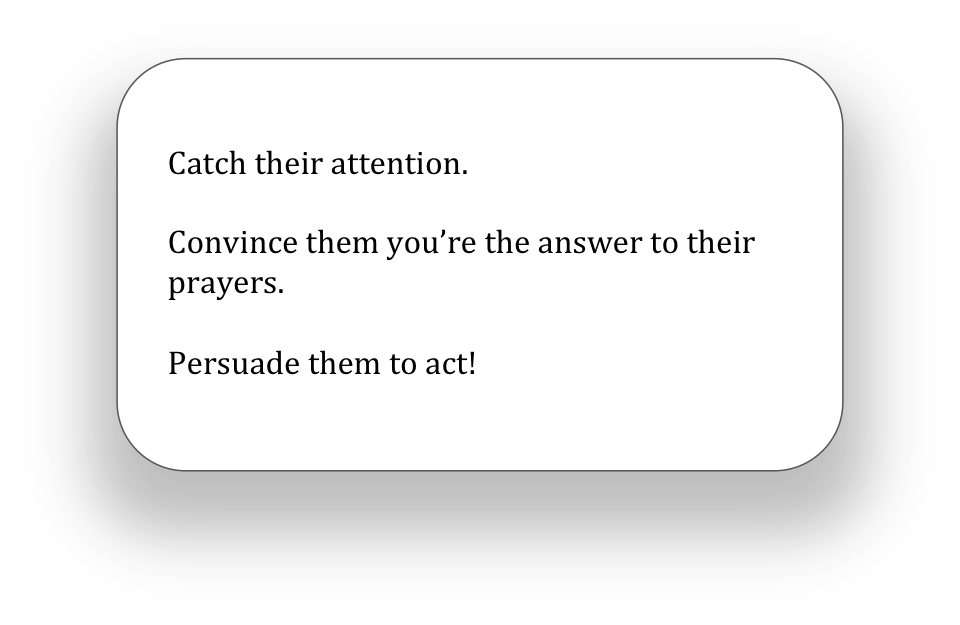4 things every website needs besides looking pretty
So, you’ve got yourself a nice looking website. But is generating any leads? 4 things your website needs.
A good looking website is paramount to a successful business. But looks aren’t everything – they’re just the surface. If you want your website to generate business, you have to dig a little deeper and ask yourself the following 4 critical questions:
“Websites should look good from the inside and out.”
― Paul Cookson, Author
1. Does your content communicate what you bring to the table?
There’s a lot of content out there that’s all about me. The truth is, consumers don’t care. They want to know what you can do for them. This means getting in their heads. What are they looking for? What problem are you solving for them? How can you communicate this in a manner they’ll related to?
Put yourself in your customers’ shoes.
What headline would catch your attention and compel you to explore further?
What would make you pick this product or service over another?
What would persuade you to buy or sign-up?
“Traditional marketing talks at people. Content marketing talks with them.” Doug Kessler, The Content Marketing Deluge
2. Are you gaining people’s trust?
These days, credibility is everything. If consumers are going to choose you, they need to believe you’re going to deliver on your promises. There are a few ways to do this:
Testimonials. The stamp of approval from previous customers or clients is a great place to start. Testimonials not only highlight your professionalism, they provide an opportunity to showcase different products or areas of expertise. If you know the customer well enough, try to steer their testimonial in a certain direction. Better still, ask them if you can write it for them! Testimonials work brilliantly scattered throughout your website and tailored to the relevant product or service page. Video testimonials are the most powerful of all because they can’t be faked.
Badges promoting a 1 year warranty, money-back guarantee or quality of workmanship highlight your efficiency and enthusiasm to provide a great service.
A convincing About Page with an approaceable, personal tone. People don’t like engaging with faceless entities, they want to know who they’re dealing with. An About Page lets you attach an identity to your brand, reveal your team (if you have one) and demonstrate your experience.
A portfolio – let your work speak for itself.
Client logos to showcase the clients and brands you’ve worked with. People will be more inclined to use your services if they can see a history of solid client relationships and brands they respect.
Achievements such as awards and recognitions to prove you’re regarded highly within your industry.
Case studies that tell a success story. Use specific examples with measured outcomes to show the value in your service or products.
Contact details that reflect a professional business. The slickest website can quickly be undermined by an amateurish email address or mobile number. A 1300 or 1800 number and a branded email address are well worth the investment when it comes to securing the consumer’s trust.
For e-commerce sites, payment logos such as Paypal if you’re using secure checkout methods. Consumers are all too aware of the risks of credit card fraud.
3. Are you compelling people to respond?
People are visiting your website. You have their attention. What? You’re going to let them leave… just like that?
When it comes to the persuasion part, Call to Action buttons are great. Always have a goal in mind, offer a powerful incentive and make sure they click through to the most relevant page, ie. your register or buy page.
Here’s a great example:
Of course there will be many visitors who aren’t ready to commit no matter how persuasive you are. So add a useful resources page or blog where they can learn more about what you offer. It’s also a good idea to provide other avenues to connect like social media icons and newsletter signup so that you can send them your latest news and promotions.
4. How effective is your on-page SEO?
The world of SEO is a complicated, confusing place. Some businesses spend thousands hiring specialists, but when you’re starting out it’s not always an option. The good news is, there are a few basic SEO tactics you can checklist to get your website on the right track:
Are your urls SEO friendly? As in, human-readable. No digits, just words separated by hyphens (the less the better) with a limit of 2048 characters. An ideal format would be –
http://www.example.com/category-keyword/subcategory-keyword/primary-keyword.html
Is your navigation user friendly? This means clearly labeled pages and subpages, a visible search function and a site map so that users can find all your pages quickly and easily.
Does each page have a clearly defined keyword? Use tools like Google Adwords and Semrush to research the search volumes of keywords. Pick keywords that are relative to the main product or service for each page. Ideally, you want your primary keyword to appear at least 3 times on the page and within the first 100 words of text.
How effective is your title tag? Title tags show up in search results like this –
If you can, include your company name and primary keyword in your title tag.
Does your meta description intrigue people to click through? The meta description (or tag) is the info below the title in search results. It doesn’t play a huge role in SEO, but it can affect your click through rate. The ideal length is 150-160 characters (additional characters will be cut off in search results).
How compelling is your content? Google is clever these days. It no longer bases its judgment on content that’s crammed with keywords. It looks for content that’s unique and well-written, content that’s being shared across social media platforms, which users are engaging with. The more content you have, the better your chances of ranking well – that’s why blogs are a great SEO strategy.
Does each page include anchor texts? These are texts that link to another location or document on the Web. To be effective, they need to be relevant to the content they’re placed within. Be careful of using keywords too heavily in your anchor texts as this can have a negative SEO effect.
There are many more complex and time-consuming SEO strategies to consider – this is just the beginning, but it’s a good place to start.
How did you go?
If your answer to all 4 questions was YES, your website is on track to becoming one of the greatest assets your business can have.




